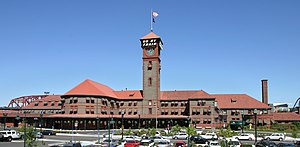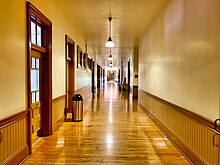Portland Union Station
This article needs to be updated. (May 2015) |
Portland Union Station | |||||||||||||||||||||||||||||||||||||||||||||||||||||||||||||||||||||||||||||||||||||||
|---|---|---|---|---|---|---|---|---|---|---|---|---|---|---|---|---|---|---|---|---|---|---|---|---|---|---|---|---|---|---|---|---|---|---|---|---|---|---|---|---|---|---|---|---|---|---|---|---|---|---|---|---|---|---|---|---|---|---|---|---|---|---|---|---|---|---|---|---|---|---|---|---|---|---|---|---|---|---|---|---|---|---|---|---|---|---|---|
 | |||||||||||||||||||||||||||||||||||||||||||||||||||||||||||||||||||||||||||||||||||||||
| General information | |||||||||||||||||||||||||||||||||||||||||||||||||||||||||||||||||||||||||||||||||||||||
| Location | 800 Northwest Sixth Avenue Portland, Oregon United States | ||||||||||||||||||||||||||||||||||||||||||||||||||||||||||||||||||||||||||||||||||||||
| Coordinates | 45°31′44″N 122°40′36″W / 45.529°N 122.6768°W | ||||||||||||||||||||||||||||||||||||||||||||||||||||||||||||||||||||||||||||||||||||||
| Owned by | City of Portland (Prosper Portland) | ||||||||||||||||||||||||||||||||||||||||||||||||||||||||||||||||||||||||||||||||||||||
| Line(s) | |||||||||||||||||||||||||||||||||||||||||||||||||||||||||||||||||||||||||||||||||||||||
| Platforms | 1 side, 2 island platforms | ||||||||||||||||||||||||||||||||||||||||||||||||||||||||||||||||||||||||||||||||||||||
| Tracks | 5 | ||||||||||||||||||||||||||||||||||||||||||||||||||||||||||||||||||||||||||||||||||||||
| Connections | |||||||||||||||||||||||||||||||||||||||||||||||||||||||||||||||||||||||||||||||||||||||
| Construction | |||||||||||||||||||||||||||||||||||||||||||||||||||||||||||||||||||||||||||||||||||||||
| Parking | Yes | ||||||||||||||||||||||||||||||||||||||||||||||||||||||||||||||||||||||||||||||||||||||
| Bicycle facilities | Yes | ||||||||||||||||||||||||||||||||||||||||||||||||||||||||||||||||||||||||||||||||||||||
| Accessible | Yes | ||||||||||||||||||||||||||||||||||||||||||||||||||||||||||||||||||||||||||||||||||||||
| Other information | |||||||||||||||||||||||||||||||||||||||||||||||||||||||||||||||||||||||||||||||||||||||
| Station code | Amtrak: PDX | ||||||||||||||||||||||||||||||||||||||||||||||||||||||||||||||||||||||||||||||||||||||
| History | |||||||||||||||||||||||||||||||||||||||||||||||||||||||||||||||||||||||||||||||||||||||
| Opened | February 14, 1896 | ||||||||||||||||||||||||||||||||||||||||||||||||||||||||||||||||||||||||||||||||||||||
| Rebuilt | 1996 | ||||||||||||||||||||||||||||||||||||||||||||||||||||||||||||||||||||||||||||||||||||||
| Passengers | |||||||||||||||||||||||||||||||||||||||||||||||||||||||||||||||||||||||||||||||||||||||
| FY 2022 | 375,071[1] (Amtrak) | ||||||||||||||||||||||||||||||||||||||||||||||||||||||||||||||||||||||||||||||||||||||
| Services | |||||||||||||||||||||||||||||||||||||||||||||||||||||||||||||||||||||||||||||||||||||||
| |||||||||||||||||||||||||||||||||||||||||||||||||||||||||||||||||||||||||||||||||||||||
| |||||||||||||||||||||||||||||||||||||||||||||||||||||||||||||||||||||||||||||||||||||||
Union Station | |||||||||||||||||||||||||||||||||||||||||||||||||||||||||||||||||||||||||||||||||||||||
Van Brunt & Howe | |||||||||||||||||||||||||||||||||||||||||||||||||||||||||||||||||||||||||||||||||||||||
| Architectural style | Romanesque Revival | ||||||||||||||||||||||||||||||||||||||||||||||||||||||||||||||||||||||||||||||||||||||
| NRHP reference No. | 75001595[2] | ||||||||||||||||||||||||||||||||||||||||||||||||||||||||||||||||||||||||||||||||||||||
| Added to NRHP | August 6, 1975 | ||||||||||||||||||||||||||||||||||||||||||||||||||||||||||||||||||||||||||||||||||||||
Portland Union Station is a
Southeast of the station, the tracks make a sharp turn and cross the river on the historic
The station is owned by the city of Portland and operated by Prosper Portland, the city's urban renewal agency. The city earns $200,000 a year from nearly 30 tenants. Amtrak, the main tenant, has a continuing lease in 2021.
Services

Union Station serves as a major
The station is one of two western termini for the Empire Builder, Amtrak's major long-distance train to the Pacific Northwest. The train splits at Spokane, with one section continuing to Portland by way of the Columbia River Gorge and the other continuing to Seattle. It is also a stop for the Seattle-Los Angeles Coast Starlight, Amtrak's long-distance West Coast train. It serves as the southern terminus for two daily Cascades trains from Vancouver, British Columbia and four daily Cascades trains from Seattle, and the northern terminus for two Cascades trains from Eugene.
As of 2018, Union Station is the fifth-busiest Amtrak station in the Western United States (behind Los Angeles, Sacramento, Seattle and Emeryville) and the 21st busiest overall.[5]
Bus connections
Portland's former
Station details
Union Station is situated near the western bank of the Willamette River in downtown Portland's Old Town Chinatown. The site is bound by Northwest Glisan, Hoyt, and Irving streets to the south; Northwest Broadway Street and Station Way to the west; Northwest Overton Street and Naito Parkway to the north; and Northwest Ironside Terrace and industrial and commercial zones to the east.[8]: 3
History

The initial design for the station was created in 1882 by
The track shelters were built in response to the expected increase in travellers arriving by rail to attend the 1905
The signature piece of the structure is the 150-foot-tall Romanesque Revival clock tower with its four-sided 1898 Seth Thomas eight-day pendulum clock, has become one of the most iconic and recognizable features of the station. Each of the clock faces is 12 feet in diameter, with a minute hand 6 feet long and an hour hand 5 feet long. The clock has a 14 foot pendulum and 1,000 pounds of counterweight that drops almost 50 feet over 7 days.[14] It is wound every seven days. Neon signs were added to the tower in 1948.[15][16] The signs read "Go by Train" on the northeast and southwest sides and "Union Station" on the northwest and southeast sides.
The nearby
Dissatisfaction with the lack of a clear, formal entry and confusing circulation patterns and dramatically increased passenger load were factors that led to the need to remodel. In 1927, the prestigious Portland architectural firm of
In 1931, a pedestal was built in the station's courtyard and the
In the early 1920's, ninety trains moved in or out of the station daily, 52 steam trains and 38 electrics; a train would arrive or depart about every 11 minutes. Expansion of service at Union Station related to the Spokane, Portland and Seattle Railway line in 1920s required significant changes to the building and track, and at its peak period of operation in the late 1940s Union Station had as many as 30 separate tracks, continuing east to Front Avenue. Over time, freight rail became less utilized as some businesses turned to trucks instead of railroads for shipment of goods.[20]
In the years prior to Amtrak's assuming passenger operations on May 1, 1971, the
The station was placed on the National Register of Historic Places in 1975.[21]
The neon signs on the tower went dark in March 1971, because the railroads using it,

In 1987, ownership of the station and surrounding land was transferred from Portland Terminal Railroad to the Portland Development Commission (now Prosper Portland) as part of the Downtown/Waterfront urban-renewal district.[24] Shortly afterwards, Union Station underwent a renovation. It was rededicated in 1996 for its 100th anniversary.
In 2004, the roadway in front of the station was reconfigured, providing a new connection to the northwest and a forecourt. In addition, the area is being redeveloped, including new housing where railroad tracks once were.
In 2023, Prosper Portland re-evaluated the alignment of its continued ownership of Portland Union Station with the economic development mission of the agency. They have concluded that it is in the City of Portland’s and the Station’s best long-term interest to align ownership of this asset with an entity with a transportation mission. As a result, Prosper Portland has begun to explore the sale of the Station and does not anticipate taking any further actions to pursue any renovation plans.[25]
See also
- North Bank Depot – former train station located nearby
- Tourism in Portland, Oregon
References
- ^ "Amtrak Fact Sheet, Fiscal Year 2022: State of Oregon" (PDF). Amtrak. June 2023. Retrieved August 30, 2023.
- ^ "National Register Information System". National Register of Historic Places. National Park Service. July 9, 2010.
- ^ Metropolitan Lounge, trainweb.com.
- ^ Amtrak Cascades, amtrak.com. Retrieved January 23, 2019.
- ^ "Amtrak national fact sheet FY2018" (PDF).
- ^ Erickson, Steve (September 11, 1985). "Greyhound depot reaches end of line; new terminal opens in NW Portland". The Oregonian.
- ^ Theen, Andrew (September 9, 2019). "Portland Greyhound station moves out; terminal site in NW up for sale". The Oregonian. Retrieved May 19, 2020.
- ^ Summary of Alternatives Considered Union Station Building and Track Improvements Project (PDF) (Report). Portland Development Commission. November 2016. Retrieved May 19, 2020.
- ^ Giarelli, Andrew (May 3, 2007). "A 'pretty scary place' turns around". The Oregonian. p. B3.
- ^ Weaver, Mary L. (1987). Window to the Past: A Union Station Album. Northwest Rail Museum.
- ^ Norwood, Lisa. "Portland Union Station".
- ISBN 978-1-4671-1567-4.
- ^ a b c Johnson, Ian (March 16, 2016). "Scanned Document - Union-Station-Rev-Determination-of-Natl-Reg-of-Historic-Places-Eligibility.pdf" (PDF). prosperportland.us. US Department of Transportation. Retrieved December 5, 2023.
- ^ West, Robert D. (February 8, 2015). "PlacesPages: Portland Places: Union Station".
- ^ a b c d Federman, Stan (May 1, 1985). "Rail clock buffs want to light up your life". The Oregonian. p. 1.
- ISBN 978-0-7385-9324-1.
- ^ "Portfolio | Portland Union Station". Architectural Resources Group (ARG).
- ^ "TM-1962-02.pdf" (PDF). pnwc-nrhs.org/. National Railway Historical Society. February 19, 1962. Retrieved December 5, 2023.
- ^ Terry, Jeff (April 2022). "Legacy of the Oregon Pony" (PDF). pnwc-nrhs.org. National Railway Historical Society. Retrieved December 5, 2023.
- ISBN 978-0295972107.
- ^ "National Register of Historic Places - Oregon, Multnomah County". Retrieved 2007-05-02.
- ^ a b McCarthy, Nancy (July 25, 1985). "Train-station signs add color". The Oregonian. p. B6.
- ^ "Sneak preview" (photograph and caption). The Oregonian, September 19, 1985, p. 1.
- ^ Giarelli, Andrew (May 3, 2007). "Union Station has more needs than funds". The Oregonian. p. B3.
- ^ Haack, Shelly (July 11, 2023). "Portland Union Station PA DRAFT - Portland-Union-Station-PA-Annual-Report-22-23.pdf" (PDF). prosperportland.us. Prosper Portland. Retrieved December 5, 2023.
External links
- Portland, OR – Amtrak
- Portland, OR – Station history at Great American Stations (Amtrak)
- "All Aboard!" at Union Station, 1896 Oregonian article on Union Station opening
